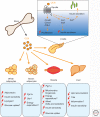Regulation of Energy Metabolism by Bone-Derived Hormones
- PMID: 28778968
- PMCID: PMC5983159
- DOI: 10.1101/cshperspect.a031666
Regulation of Energy Metabolism by Bone-Derived Hormones
Abstract
Like many other organs, bone can act as an endocrine organ through the secretion of bone-specific hormones or "osteokines." At least two osteokines are implicated in the control of glucose and energy metabolism: osteocalcin (OCN) and lipocalin-2 (LCN2). OCN stimulates the production and secretion of insulin by the pancreatic β-cells, but also favors adaptation to exercise by stimulating glucose and fatty acid (FA) utilization by the muscle. Both of these OCN functions are mediated by the G-protein-coupled receptor GPRC6A. In contrast, LCN2 influences energy metabolism by activating appetite-suppressing signaling in the brain. This action of LCN2 occurs through its binding to the melanocortin 4 receptor (MC4R) in the paraventricular nucleus of the hypothalamus (PVN) and ventromedial neurons of the hypothalamus.
Copyright © 2018 Cold Spring Harbor Laboratory Press; all rights reserved.
Figures





Similar articles
-
MC4R-dependent suppression of appetite by bone-derived lipocalin 2.Nature. 2017 Mar 16;543(7645):385-390. doi: 10.1038/nature21697. Epub 2017 Mar 8. Nature. 2017. PMID: 28273060 Free PMC article.
-
Multiligand specificity and wide tissue expression of GPRC6A reveals new endocrine networks.Endocrinology. 2012 May;153(5):2062-9. doi: 10.1210/en.2011-2117. Epub 2012 Feb 28. Endocrinology. 2012. PMID: 22374969 Free PMC article. Review.
-
Explaining Divergent Observations Regarding Osteocalcin/GPRC6A Endocrine Signaling.Endocrinology. 2021 Apr 1;162(4):bqab011. doi: 10.1210/endocr/bqab011. Endocrinology. 2021. PMID: 33474566 Free PMC article. Review.
-
Associations between circulating bone-derived hormones lipocalin 2, osteocalcin, and glucose metabolism in acromegaly.J Endocrinol Invest. 2020 Sep;43(9):1309-1316. doi: 10.1007/s40618-020-01221-9. Epub 2020 Mar 20. J Endocrinol Invest. 2020. PMID: 32198716
-
Bone: Another potential target to treat, prevent and predict diabetes.Diabetes Obes Metab. 2018 Aug;20(8):1817-1828. doi: 10.1111/dom.13330. Epub 2018 May 14. Diabetes Obes Metab. 2018. PMID: 29687585 Review.
Cited by
-
Association of serum osteocalcin levels with glucose metabolism in trauma patients.Medicine (Baltimore). 2020 Sep 4;99(36):e21901. doi: 10.1097/MD.0000000000021901. Medicine (Baltimore). 2020. PMID: 32899020 Free PMC article.
-
Diabetic Bone Disease and Diabetic Myopathy: Manifestations of the Impaired Muscle-Bone Unit in Type 1 Diabetes.J Diabetes Res. 2022 May 12;2022:2650342. doi: 10.1155/2022/2650342. eCollection 2022. J Diabetes Res. 2022. PMID: 35601019 Free PMC article. Review.
-
Osteocalcin attenuates oligodendrocyte differentiation and myelination via GPR37 signaling in the mouse brain.Sci Adv. 2021 Oct 22;7(43):eabi5811. doi: 10.1126/sciadv.abi5811. Epub 2021 Oct 22. Sci Adv. 2021. PMID: 34678058 Free PMC article.
-
Emerging and Established Models of Bone Metastasis.Cancers (Basel). 2018 Jun 1;10(6):176. doi: 10.3390/cancers10060176. Cancers (Basel). 2018. PMID: 29865211 Free PMC article. Review.
-
The Interplay Between Bone and Glucose Metabolism.Front Endocrinol (Lausanne). 2020 Mar 24;11:122. doi: 10.3389/fendo.2020.00122. eCollection 2020. Front Endocrinol (Lausanne). 2020. PMID: 32265831 Free PMC article. Review.
References
-
- Bonneau J, Ferland G, Karelis AD, Doucet E, Faraj M, Rabasa-Lhoret R, Ferron M. 2017. Association between osteocalcin γ-carboxylation and insulin resistance in overweight and obese postmenopausal women. J Diabetes Complications 31: 1027–1034. - PubMed
-
- Borges BC, Rorato R, Avraham Y, da Silva LE, Castro M, Vorobiav L, Berry E, Antunes-Rodrigues J, Elias LL. 2011. Leptin resistance and desensitization of hypophagia during prolonged inflammatory challenge. Am J Physiol Endocrinol Metab 300: E858–E869. - PubMed
-
- Cornish J, Callon KE, Bava U, Lin C, Naot D, Hill BL, Grey AB, Broom N, Myers DE, Nicholson GC, et al. 2002. Leptin directly regulates bone cell function in vitro and reduces bone fragility in vivo. J Endocrinol 175: 405–415. - PubMed
Publication types
MeSH terms
Substances
Grants and funding
LinkOut - more resources
Full Text Sources
Other Literature Sources
Medical
Miscellaneous
